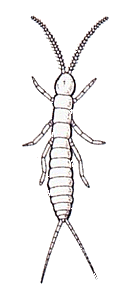Diplura
Pronunciation: [Di·PLUR·a]
Pronunciation: [Di·PLUR·a]
Common Name: Diplurans
Greek Origins of Name: Diplura, derived from the Greek words “diplo-” meaning two and “ura” meaning tails, refers to the large cerci at the rear of the abdomen.
Ametabola, i.e. lacking metamorphosis; eggs hatch into young which are smaller than adults, but similar in appearance.
Apterygota; primitively wingless
Common in grassy or wooded habitats worldwide, but seldom seen because of their small size and reclusive habits. Approximately 5 families and 64 species in North America and 7 families and >800 species worldwide.
These small, eyeless arthropods are considered to be among the most primitive of all hexapods. They have a pair of long, beaded antennae on the head and a pair of segmented sensory structures (cerci) at the rear. In one common family (Japygidae), these cerci are developed into strong pincers.
Diplura are tiny, cryptozoic animals that live in moist soil, leaf litter, or humus. They have small, eversible vesicles on the ventral side of most abdominal segments that seem to help regulate the body’s water balance, perhaps by absorbing moisture from the environment.
Most Diplura are predators; their diet probably includes a wide variety of other soil-dwellers, including collembola, mites, symphyla, insect larvae, and even other diplurans. They may also survive on vegetable debris and fungal mycelia, but most species seem to prefer animal prey.

Diplurans are common inhabitants of forest leaf litter. They are part of the community of decomposers that help break down and recycle organic nutrients. None of the Diplura are considered pests.
Campodeidae — approximately 34 North American species, all of which have long cerci (10-segments).
Japygidae — 28 North American species, all of which have short (unsegmented) cerci in the form of pincers (forceps).